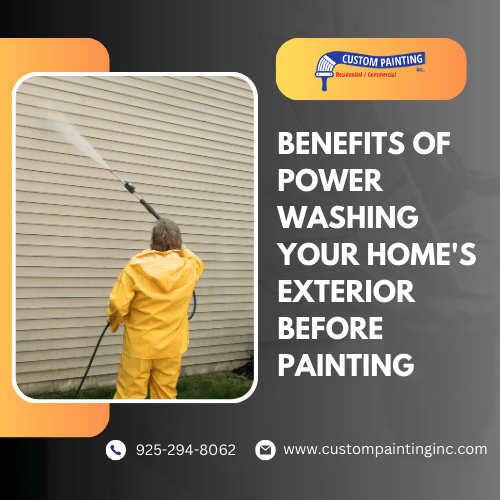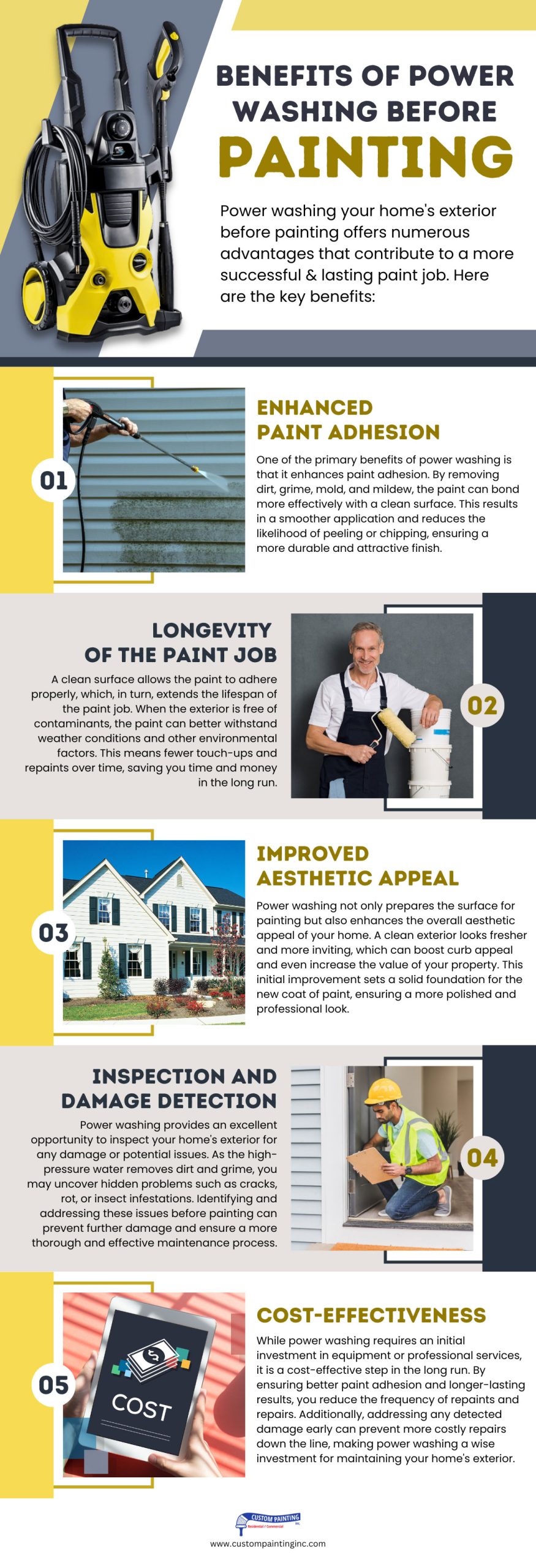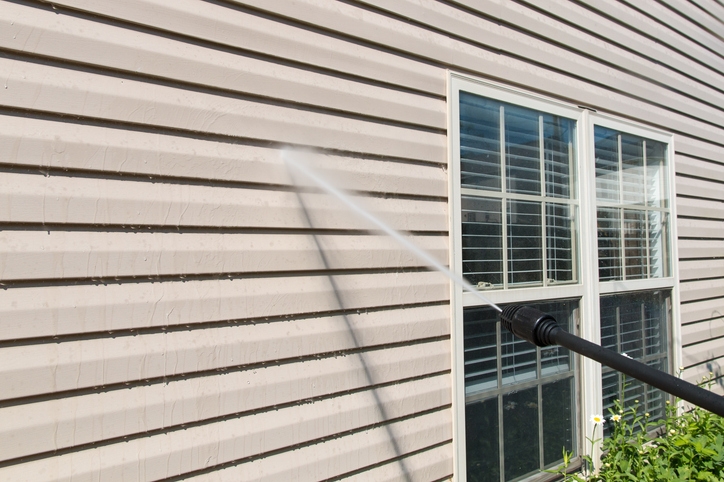Maintaining a Pleasanton, CA area home is crucial for preserving its value and ensuring it remains a safe, comfortable place to live. One key aspect of home maintenance is exterior painting, which not only enhances the curb appeal but also provides a protective layer against the elements. However, before you dive into painting, there’s an important preparatory step that can make a significant difference: power washing.
Let us discover the benefits of power washing your home’s exterior before painting. Find out how this simple step can lead to a smoother, more durable finish while also improving the overall look and longevity of your paint job.
What is Power Washing?
Power washing, also known as pressure washing, is a cleaning method that uses high-pressure water spray to remove dirt, grime, mold, mildew, and other contaminants from surfaces. This technique is particularly effective for cleaning exterior surfaces such as walls, driveways, decks, and sidewalks.
It involves the use of a high-pressure water spray to clean surfaces. The water is forced through a nozzle at high speeds, which allows it to break down and remove stubborn dirt and debris. This method is highly effective for cleaning large areas quickly and thoroughly, making it a popular choice for homeowners looking to refresh their exteriors.
Tools and Equipment Used
To perform power washing, you need a few essential tools and equipment:
- Pressure Washer: The main tool, available in both electric and gas-powered models. Electric pressure washers are typically lighter and quieter, while gas-powered ones offer more power for tougher jobs.
- Nozzles and Tips: Various nozzles can be attached to the pressure washer to control the spray pattern and pressure. Different tips are used for different cleaning tasks, such as a narrow spray for tough stains or a wider spray for larger surfaces.
- Hose and Attachments: High-pressure hoses connect the pressure washer to the water source. Attachments like surface cleaners and extension wands can enhance cleaning efficiency and reach.
- Safety Gear: Goggles, gloves, and protective clothing are important to ensure safety while operating the pressure washer.
Comparison with Other Cleaning Methods
Power washing stands out when compared to other cleaning methods due to its efficiency and effectiveness:
- Hand Scrubbing: While hand scrubbing can be effective for small areas or delicate surfaces, it is labor-intensive and time-consuming for large areas.
- Chemical Cleaners: Chemical cleaners can remove dirt and grime, but they often require scrubbing and can pose environmental and health risks. Power washing, on the other hand, uses only water, making it a safer and more eco-friendly option.
- Soft Washing: Soft washing uses low-pressure water combined with cleaning solutions to remove contaminants. This method is gentler on surfaces but may not be as effective on tough stains or heavily soiled areas as power washing.
In summary, power washing is a highly efficient and effective cleaning method for preparing your home’s exterior for painting. By understanding the tools and techniques involved, homeowners can achieve a cleaner, more attractive surface that ensures better paint adhesion and a longer-lasting finish.
Benefits of Power Washing Before Painting
Power washing your home’s exterior before painting offers numerous advantages that contribute to a more successful and lasting paint job. Here are the key benefits:
Enhanced Paint Adhesion
One of the primary benefits of power washing is that it enhances paint adhesion. By removing dirt, grime, mold, and mildew, the paint can bond more effectively with a clean surface. This results in a smoother application and reduces the likelihood of peeling or chipping, ensuring a more durable and attractive finish.
Longevity of the Paint Job
A clean surface allows the paint to adhere properly, which, in turn, extends the lifespan of the paint job. When the exterior is free of contaminants, the paint can better withstand weather conditions and other environmental factors. This means fewer touch-ups and repaints over time, saving you time and money in the long run.
Improved Aesthetic Appeal
Power washing not only prepares the surface for painting but also enhances the overall aesthetic appeal of your home. A clean exterior looks fresher and more inviting, which can boost curb appeal and even increase the value of your property. This initial improvement sets a solid foundation for the new coat of paint, ensuring a more polished and professional look.
Inspection and Damage Detection
Power washing provides an excellent opportunity to inspect your home’s exterior for any damage or potential issues. As the high-pressure water removes dirt and grime, you may uncover hidden problems such as cracks, rot, or insect infestations. Identifying and addressing these issues before painting can prevent further damage and ensure a more thorough and effective maintenance process.
Cost-Effectiveness
While power washing requires an initial investment in equipment or professional services, it is a cost-effective step in the long run. By ensuring better paint adhesion and longer-lasting results, you reduce the frequency of repaints and repairs. Additionally, addressing any detected damage early can prevent more costly repairs down the line, making power washing a wise investment for maintaining your home’s exterior.
Power washing before painting your home’s exterior is a crucial step that offers numerous benefits. From enhancing paint adhesion and extending the longevity of the paint job to improving aesthetic appeal and enabling damage detection, power washing ensures a more successful and cost-effective painting project.
The Power Washing Process
Power washing your home’s exterior is a straightforward process, but it requires careful preparation and attention to safety to ensure effective and safe cleaning. Here’s a detailed look at the power washing process, including preparation, a step-by-step guide, and considerations for hiring professionals versus doing it yourself.
Preparation and Safety Measures
Before you start power washing, it’s important to prepare both the area and yourself:
- Protect Plants and Furniture: Cover any plants, outdoor furniture, and electrical outlets to protect them from the high-pressure water and detergent.
- Wear Safety Gear: Use safety goggles, gloves, and non-slip shoes to protect yourself from potential hazards.
- Inspect the Area: Check for any loose siding, damaged surfaces, or areas that might need special attention to avoid causing further damage.
Step-by-Step Guide
- Pre-rinsing and Detergent Application
- Pre-rinse the Surface: Start by pre-rinsing the area with water to remove loose dirt and debris. This helps the detergent work more effectively.
- Apply Detergent: Use a detergent designed for power washing and apply it evenly across the surface. Allow it to sit for a few minutes to break down grime, but avoid letting it dry completely.
- Pressure Washing Technique
- Select the Right Nozzle: Choose the appropriate nozzle for the job. A 25-degree nozzle is typically a good starting point for general cleaning.
- Start Power Washing: Begin at the top of the area and work your way down. Hold the nozzle at a slight angle and keep a consistent distance from the surface, usually around 12 to 18 inches.
- Use Smooth, Even Strokes: Move the spray in smooth, even strokes to ensure even cleaning and prevent streaks or damage.
- Rinsing and Drying
- Rinse Thoroughly: After cleaning, rinse the entire area thoroughly to remove all detergent residue. Again, start from the top and work your way down.
- Allow to Dry: Let the surface dry completely before applying paint. This ensures the paint will adhere properly and last longer.
Hiring Professionals vs. DIY Approach
1. Hiring Professionals
- Expertise: Professionals have the experience and knowledge to handle various surfaces and conditions, ensuring optimal results.
- Equipment: They use commercial-grade equipment that is often more powerful and effective than consumer models.
- Time and Convenience: Hiring professionals saves you time and effort, allowing you to focus on other tasks.
2. DIY Approach
- Cost Savings: Doing it yourself can be more cost-effective, especially if you already own a pressure washer or can rent one affordably.
- Control: You have complete control over the process, allowing you to work at your own pace and address specific areas of concern.
- Satisfaction: Completing the job yourself can be rewarding and give you a sense of accomplishment.
Power washing is an essential preparatory step before painting your home’s exterior. By following the proper process and safety measures, you can achieve a clean and ready surface that ensures better paint adhesion and a longer-lasting finish. Whether you choose to hire professionals or take the DIY approach, power washing is a valuable investment in your home’s maintenance and appearance.
Common Mistakes to Avoid
While power washing can significantly enhance the quality and durability of your home’s exterior paint job, it’s essential to avoid common mistakes that can lead to damage or unsatisfactory results. Here are some key mistakes to watch out for:
Using Excessive Pressure
One of the most common mistakes is using too much pressure. High-pressure water can damage your home’s siding, strip paint, and even cause cracks in the surfaces you’re trying to clean. To avoid this:
- Start with Lower Pressure: Always begin with the lowest pressure setting that is effective and gradually increase if necessary.
- Choose the Right Nozzle: Use a nozzle with a wider spray pattern to distribute the pressure more evenly. Narrow nozzles can concentrate the pressure and cause damage.
- Maintain Proper Distance: Keep the nozzle at least 12 to 18 inches away from the surface to prevent damage.
Ignoring Safety Precautions
Power washing involves using high-pressure water, which can be dangerous if not handled properly. Ignoring safety precautions can lead to accidents and injuries. To stay safe:
- Wear Protective Gear: Always wear safety goggles, gloves, and non-slip shoes to protect yourself from flying debris and water spray.
- Be Cautious of Electrical Hazards: Avoid spraying water near electrical outlets, lights, and other electrical fixtures. Cover them with waterproof materials if necessary.
- Be Aware of Surroundings: Ensure pets, children, and bystanders are at a safe distance from the working area to prevent accidental injuries.
Skipping Necessary Repairs Before Painting
Power washing is an excellent opportunity to inspect your home’s exterior for damage. Skipping necessary repairs before painting can lead to problems down the line. To ensure a durable and effective paint job:
- Inspect Thoroughly: Look for signs of damage such as cracks, rot, or loose siding. Pay special attention to areas that are not easily visible.
- Make Repairs: Address any issues you find before proceeding with painting. This might include filling cracks, replacing damaged siding, or treating mold and mildew.
- Clean Again if Necessary: After making repairs, you may need to clean the area again to remove dust and debris from the repair process.
Avoiding these common mistakes when power washing can help ensure a successful and safe preparation for painting your home’s exterior. By using the right pressure, following safety precautions, and addressing necessary repairs, you can achieve a cleaner surface that enhances the adhesion and longevity of your paint job.
Conclusion
Power washing is a crucial preparatory step that can significantly improve the outcome of your home’s exterior paint job. By ensuring better paint adhesion, longer-lasting results, and a cleaner, more attractive surface, power washing plays a vital role in maintaining and enhancing your home’s exterior. For professional assistance, contact Custom Painting, Inc. at 925-866-9610 or reach out through our contact form. Take the first step towards a beautifully painted and well-maintained home today.



